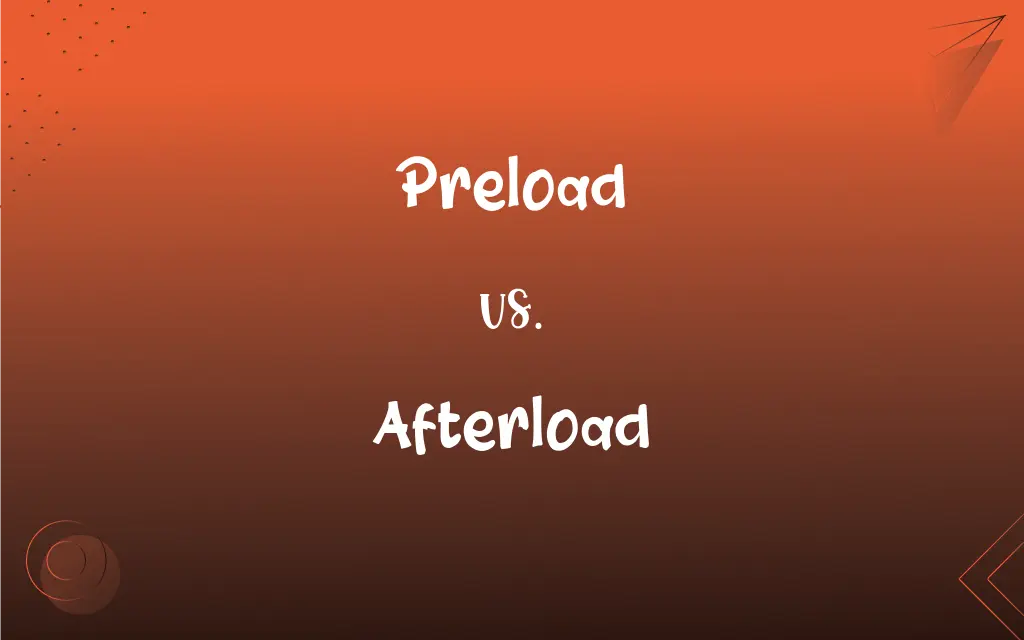Preload vs. Afterload: What's the Difference?
Edited by Aimie Carlson || By Janet White || Published on March 2, 2024
Preload refers to the degree of ventricular stretch at the end of diastole, while afterload is the resistance the heart must overcome to eject blood.

Key Differences
Preload is the initial stretching of the cardiac myocytes prior to contraction, determined by venous return and end-diastolic volume. Afterload, on the other hand, is the force or resistance against which the heart has to contract to eject blood.
Preload affects the stroke volume according to the Frank-Starling law, where an increase in preload leads to an increase in stroke volume. Afterload, however, can decrease stroke volume if it becomes excessively high, as it requires the heart to work harder to eject blood.
Preload is a critical factor in conditions like heart failure and hypovolemia, where managing fluid volume can improve cardiac output. Afterload is significant in hypertension and aortic stenosis, where reducing afterload can alleviate the heart's workload.
Preload is often assessed indirectly through measurements like central venous pressure or pulmonary capillary wedge pressure. Afterload is assessed through systemic vascular resistance or arterial blood pressure.
Preload can be adjusted through fluid management, using diuretics to reduce preload or fluids to increase it. Afterload can be modified with medications like vasodilators, which reduce the resistance the heart must pump against.
ADVERTISEMENT
Comparison Chart
Definition
Degree of ventricular stretch at end-diastole
Resistance heart must overcome to eject blood
Influences
Stroke volume via Frank-Starling law
Stroke volume negatively if high
Clinical Relevance
Important in heart failure, hypovolemia
Significant in hypertension, aortic stenosis
Measurement
Indirectly via central venous pressure
Assessed through systemic vascular resistance
Therapeutic Interventions
Managed with fluid management
Modified with vasodilators
ADVERTISEMENT
Preload and Afterload Definitions
Preload
The stretching of ventricular muscle fibers prior to contraction.
Preload is determined by the degree of ventricular stretch.
Afterload
Influences the stress on the ventricular wall during systole.
Afterload is a key factor in ventricular wall stress.
Preload
A factor that influences the volume of blood ejected per heartbeat.
Adjusting preload can help optimize stroke volume.
Afterload
The force against which the heart must contract to eject blood.
High afterload can strain the heart and reduce efficiency.
Preload
The volume of blood in the ventricle at the end of diastole.
An increase in preload can enhance cardiac output.
Afterload
Reflects the pressure the heart must overcome.
Afterload is often elevated in patients with hypertension.
Preload
A parameter targeted in fluid therapy.
In heart failure management, controlling preload is crucial.
Afterload
Affected by the tone of the arterial system.
Vasodilators can reduce afterload by decreasing vascular tone.
Preload
Reflects the amount of blood returning to the heart.
Preload provides insight into venous return and cardiac filling.
Afterload
A parameter addressed by certain medications.
Medications that lower afterload can improve cardiac function.
Preload
To load (something) in or onto a device or conveyance in advance of use or need
Preloaded the dirty socks in the washer to allow them to soak for half an hour.
Afterload
(physiology) The load on a working muscle from a constant opposing force
FAQs
What is preload in the heart?
Preload is the degree of stretch of the cardiac muscle fibers at the end of diastole, just before contraction.
Can preload and afterload be measured directly?
Preload and afterload are typically assessed indirectly through surrogate measures like central venous pressure and systemic vascular resistance.
What factors influence afterload?
Afterload is influenced by factors such as arterial blood pressure, vascular resistance, and the condition of the aortic valve.
How are preload and afterload related to heart failure?
In heart failure, managing preload and afterload is crucial; reducing preload can alleviate symptoms of congestion, while reducing afterload can improve cardiac efficiency.
How do changes in afterload affect the heart's workload?
Changes in afterload directly affect the heart's workload; an increase in afterload increases the work required for the heart to eject blood.
How do preload and afterload affect cardiac output?
Preload influences cardiac output via the Frank-Starling mechanism, while afterload can decrease cardiac output if it becomes too high.
How do changes in preload affect stroke volume?
Changes in preload can affect stroke volume; an increase in preload generally leads to an increase in stroke volume, according to the Frank-Starling law.
How can preload and afterload be optimized in clinical settings?
Preload and afterload can be optimized through careful fluid management, use of vasodilators, and monitoring of hemodynamic parameters.
What is afterload in the heart?
Afterload is the resistance the heart must overcome to eject blood during systole.
What medications affect preload and afterload?
Diuretics can reduce preload by decreasing blood volume, while vasodilators can reduce afterload by lowering vascular resistance.
What is the relationship between preload, afterload, and the Frank-Starling law?
The Frank-Starling law describes the relationship between preload and stroke volume, while afterload is a separate factor that influences the heart's ability to eject blood.
What factors influence preload?
Preload is influenced by factors such as venous return, total blood volume, and atrial contraction.
What role do preload and afterload play in hypertension?
In hypertension, afterload is often increased, leading to higher demands on the heart; managing preload and afterload is key in treatment.
How do preload and afterload affect myocardial oxygen demand?
Both preload and afterload can influence myocardial oxygen demand; an increase in either can raise the heart's oxygen requirements.
What are the clinical implications of altered preload and afterload in cardiac surgery?
In cardiac surgery, managing preload and afterload is vital to ensure adequate cardiac function and minimize stress on the heart.
How do preload and afterload contribute to cardiac remodeling?
Chronic changes in preload and afterload can lead to cardiac remodeling, affecting the heart's structure and function.
How do preload and afterload affect ventricular function?
Preload affects ventricular filling and stretch, while afterload affects the force required for ventricular ejection.
What is the impact of preload and afterload on cardiac arrhythmias?
Alterations in preload and afterload can affect the electrical properties of the heart, potentially contributing to arrhythmias.
What is the significance of preload and afterload in pharmacological stress testing?
In pharmacological stress testing, changes in preload and afterload can provide insights into cardiac function and reserve.
How do preload and afterload interact in the context of valvular heart disease?
In valvular heart disease, preload and afterload are key considerations, as they can be significantly affected by valvular dysfunction and impact treatment strategies.
About Author
Written by
Janet WhiteJanet White has been an esteemed writer and blogger for Difference Wiki. Holding a Master's degree in Science and Medical Journalism from the prestigious Boston University, she has consistently demonstrated her expertise and passion for her field. When she's not immersed in her work, Janet relishes her time exercising, delving into a good book, and cherishing moments with friends and family.
Edited by
Aimie CarlsonAimie Carlson, holding a master's degree in English literature, is a fervent English language enthusiast. She lends her writing talents to Difference Wiki, a prominent website that specializes in comparisons, offering readers insightful analyses that both captivate and inform.
































































